|
|
| home > files |
| Turbulent Grid.
Dirty Geometry (part 1) Peter Macapia |
||||
| Peter
Macapia, professor in the Graduate Architecture and Urban Design
(GAUD) program at Pratt Institute and in the Graduate School of
Architecture, Planning and Preservation (GSAPP) program at Columbia
University in New York City, offers to the readers of ARCH'IT a
two-part essay on the geometry of material organization. By means
of algorithmic studies of fluid dynamics and polygonal tessellation,
Peter introduces us to problems inherent to structures.
CFD (computational fluid dynamics) and FEA (finite element analysis)
are just two of the tools adopted for this research and presented in "Dirty
Geometry". [Paola Giaconia] |
||||
| PRESSURE.
There is always pressure. And then there is that kind of pressure in which the relationship between things suddenly shifts. Is this simply a phenomenon of reordering? Or it not the case that the elements themselves suddenly altar? "Ecology" is at once a proposition about these state of affairs and, in a distant way, a means of calibrating them. Think of it as fine-tuning. But in this sense one should also speak of an ecology of techniques. Herein lay the problem of design in contemporary cities of high density. In fact, of design in general. For insofar as the demand for buildings to do certain things is experiencing increasing pressure with regard to matter/energy relations and insofar as the means to analyze such features is increasingly spreading out across the domain of computation, then design itself, it would seem, is mutating. And even if geometry and the geometry of matter/energy relations is not the content of design, and even if design is becoming more like engineering, it is still a question of geometry. Only this geometry, like the changing nature of architecture's ontology, has yet to exist. It is not given. |
[06feb2007] |
|||
 Project study, lightweight structure and membrane, NYC vacant lot. We are beginning to understand that geometry is dirty -in two senses. Generative scripting is in essence unrefined. Its formal language is highly structured but its application is idiomatic and rough, its logic always local (it is not clear, for example, that one can prima facie spatially distribute the algorithmic terms of an l-system without adding arbitrary -external- rules). Generative Components, for example, may give us the suite of tools and mathematical expressions we need to apply structure to a surface, but in this system "structure" is an idle gear – it is not testable as a physical phenomenon. On the other hand, when it comes to looking at geometry as something situated in and reciprocal with physical environment (and in that sense global), its formal nature can no longer be understood as a higher topological entity. A regular cube designed in any standard CAD program with eight points, six surfaces, and twelve edges, in the parlance of the CAD industry, is inherently dirty. Its tolerances and topological features are inadequate for testing, for example in Computational Fluid Dynamics. The cube has to be "cleaned up," part of which involves dissolving its apparent topological features and then meshed through algorithms that adapt the surface and the volume to continuous yet discrete elements. |
 Meshed cube for CFD analysis. |
|||
 CFD (Computational Fluid Dynamics) study for porous membrane using geometrical primitive. |
The
very identity of geometry has shifted within this domain of computation.
The turbulence of pattern begins to emerge with (and in some cases
conflict with) what we used to call Form. Between scripting and analysis
we have then intense Formalism and extensive physics. And both are
in a way wild. But there is no computational program nor method that
captures these aspects in one gesture. It is part of the designer's
role to invent a space of operations in which we move from one set
of propositions to another and thereby invent new terms for the categories
that define architecture's ontology. It can't be otherwise. Is it simply coincidence that every major CAD company is seeking to refine both the intricacy of geometrical expression and its testability in the environment at a time when the very notion of design is increasingly experiencing new political, social, and energy demands? There may not be a direct correlation. It is quite possible that our emerging uses of computation is simply an effect of the of greater processing power. Perhaps. Though perhaps it is in part a consequence of the changing nature of how we see architecture no longer as a point or an object in space, but rather as a function, a function of grids, of networks, of gradients. After all, we are in a situation in which half the world's population is now moving to cities of one million or more as well as the fact that (by some estimates) buildings constitute half our energy consumption (from development, to operation, to destruction).  Viollet-le-Duc, design for a market hall, 1864. The grid has become turbulent, and the geometry dirty. It is incredibly suggestive and just as naïve to exchange the possibility of design within this context for metaphors from biology and Nature. Perhaps we should think of design not as a "solution," but as a continuous set of experiments with pressure. Surely geometry, when submitted to such pressure, will provide a number of unforeseen aspects that can only lead to incredible forms of experience, socially and spatially. Architecture, I want to say, is not an answer to problems of sustainability any more than it is the product of an equation (though that is certainly one possibility). Architecture always has an excess that overflows. But at the same time it would be a mistake to think that it shouldn't participate, and to the highest degree possible, and with the most advanced and available technologies, and with the greatest collaborative spirit with, say, engineering, and not submit itself to the same pressures of turbulence and raw matter. DENSITY. The historical background for this project belongs to architectural ideas developed out of problems of urban density. Viollet-le-Duc's interest in modern tectonics, materials, and engineering was coupled with a prescient notion of the city as a machine for density, which, in his proposal for a Market Hall, he topologically reconfigured by displacing the building's relation to the ground. Less than a century later, Hannes Meyer's Petersschule competition entry would propose something similar through what is perhaps the first computational design (he used a series of equations to define the parameters of the design. The competition entry is more like an excel spreadsheet). |
|||
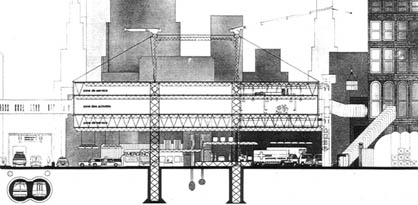 Renzo Piano, project for an emergency hospital, London (date uncertain, mid 70s?). Like Viollet-le-Duc, Meyer integrated modern technology, environmental and structural engineering with design and did so in a way that responded to the pressures as a function of gradient relations. A more contemporary version is of course to be found in projects like Renzo Piano's design for an emergency hospital, which erects itself in the middle of urban traffic. At stake today is not just a notion of advanced engineering and mechanics (these are static modes of geometrical inquiry, they are statements), or the spread-sheet calculations in Meyer and Le Corbusier alike (for example in the City of Tomorrow) but advanced computation and scripting. |
 Hannes Meyer, competition entry for Petersschule, 1927. Notice that the entry is almost entirely expressed through parametric equations. |
|||
 Tokyo International Forum behind TMIT expressway and department stores, Yurakucho, Chiyoda-ku, Tokyo.  Two story restaurant beneath TMIT expressway, Yurakucho, Chiyoda-ku, Tokyo. |
 Tokyo International Forum, Rafael Vinoly, 1996, Chiyoda-ku, Tokyo. This issue takes us back to JNL Durand's reformulation of the Vitruvian tradition and the emphasis on not only economy in general, but also economy of means. Spreading a base grammar across a gridded sheet in the form of squares, circles and semi-circles, Durand began to mix the discourses of engineering and architecture by offering the student an alternative logic, a complete syntactical system, for generating a design. |
|||
 Graveyard suspended above an expressway, Sendagaya, Shibuya-ku, Tokyo. |
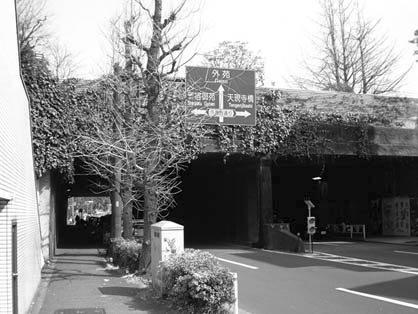 Graveyard suspended above an expressway, Sendagaya, Shibuya-ku, Tokyo. Rationality is beside the point. The point was a methodology that fused two traditions that had previously split when architecture became a "teachable" art. What is different is the climate of today's urban environment as the world exchanges half its population from rural or suburban existence to city life and forces upon the grid the turbulence of matter/energy relations. |
 Miyashita Park, suspended above open air parking lot, Shibuya Jingumae, Shibuya-ku Tokyo.  Parking lot, Miyashita Park, Shibuya Jingumae, Shibuya-ku Tokyo. |
||
 Diagram based on stack effect. |
 CFD analysis of natural ventilation and stack effect using heat flux of adjacent wall surface. The work that follows is thus an expression of this ambition to retain the specific features of design intelligence geared towards experiments in computational techniques. Geometry is internal to architecture. It always has been. But today, and perhaps for the first time, it is no longer a geometry of ideality or Form or concept. Instead, it is a geometry of matter/energy relations already tending toward new typologies that have their roots in specific architectural categories but which connect to major shifts in the urban features of spatial and material organization. In specific terms it is multilingual, a larger strategy for developing an "ecology" of techniques that integrates analytical features inherent in engineering as well as the experimental aspects of architectural design method. The primary engineering tools involved in this research are Computational Fluid Dynamics (CFD) and Finite Element Analysis (FEA). TOKYO. In contemporary terms the turbulent grid finds perhaps its greatest expression in the example of Tokyo. As the research of Atelier Bow Wow has shown, Tokyo is a field of constant differentiation and reintegration at the local scale (the utterly bizarre and practical jamming of disparate programs) while at the global scale it has achieved a tremendous sense of network and continuity. The emergence of architectural and infrastructural hybrids is an exquisite lesson in pressure and density. |
 CFD analysis of local windspeeds across building envelope. |
||
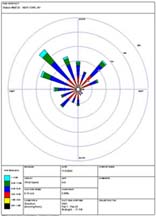 Wind rose plot for speeds, frequency, and direction for New York City during February. During the summer months, the direction is primarily South East, which indicates that there isn't sufficient cross ventilation across the site. |
 Landsat image of New York City during August, gradient indicates the hottest zones which are inverse to permeable surfaces, foliage, and light-colored or reflective roofs. Each of the hybrid sites in Tokyo reflect a strategy that emerged, without any apparent anxiety, amidst the construction and demographic boom that has faced Tokyo since the sixties. Tokyo , much like the mixed-use typological inventions by Apollodorus of Damascus in Rome , provides an important key to rethinking the relation between architecture, infrastructure, and landscape in urban environments. |
 Zoning map of the few remaining vacant lots in Manhattan. |
||
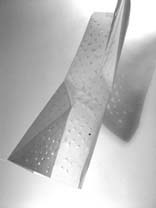 Study model for envelope with gradient apertures. |
 CFD analysis of wind velocities across envelope surface. As cities are pushing for greater and greater flexibility in zoning policies, they are increasingly interested in new models of sustainable mixed and multi-use development. This is a topological argument. The controversial but brilliant integration of program and architectural and infrastructural matter is an example, such as the graveyard above the highway in Sendagaya, the public park built above the parking lot in Shibuya Jingumae, and the hundreds of stores and restaurants crowded beneath the rail lines and expressway in Yurakucho and Ginza. FLUIDS AND MESHES. New York is less about topology and more about geometry. But the relationship between the two ought to be considered. The sites for this project are the remaining vacant lots of New York City which are temporarily used as parking space but which constitute and important part of the urban fabric's porosity. The proposition is a suspended pavilion underneath which might emerge any number of uses for public space. The suspended pavilion is much like a community garden and doesn't have a specified program. Vacant lots constitute less than 4% of New York real estate. But rather than convert these automatically into buildings it seemed perhaps the zoning could continue to develop alternatives to volumetric over-saturation. A historically critical example has been New York's "Pocket Parks" which were an emergent phenomenon during the sixties and seventies. |
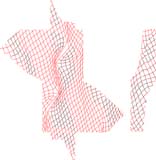 CAD drawing for envelope aperture gradient based on local wind velocities. |
||
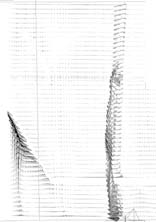 Study model for envelope with gradient apertures. 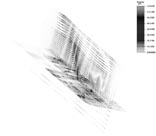 CFD analysis of ventilation and turbulence using convection and stack effect. |
 CFD schematic model of inlets and outlets for natural ventilation. On a technical level, the project attempts to develop a kind of urban hammock that is suspended between two existing buildings in order to accomplish three things: to preserve open space for public use, to use the existing walls of adjacent buildings as supplemental structural systems, and to use those walls to develop a thermal stack that will generate natural ventilation through convection. |
 Horizontal sections of internal air velocity, notice that the greatest turbulence occurs just below the stacks and towards the top of the stacks. The indication is that the higher velocities would not interfere with conventional comfort levels on the building's interior. But a the same time, one could generate an entire series of programmatic effects through the use of such turbulence. |
||
The
illustrations and simulations reflect two other concerns. One
is the ability to develop more and more interesting definitions
of a "modeled" environment. The other is to test
and develop structural scenarios that operate between tensile
and rigid mesh systems. In the case of CFD, the question is
the hourly air exchange for the building and the velocity gradients
based on thermal differences between ground air and heated
air in the thermal stacks. Horizontal sections of internal air velocity, notice that the greatest turbulence occurs just below the stacks and towards the top of the stacks. The indication is that the higher velocities would not interfere with conventional comfort levels on the building's interior. But a the same time, one could generate an entire series of programmatic effects through the use of such turbulence. In this case we are looking at using heat flux to produce convection and thus natural ventilation in a building. The larger urban problem in dense cities like Manhattan is of course the urban heat island effect. The project thus also addresses various forms of mitigation. |
||||
 CFD generated mesh using high surface tension liquid. One of the important things about grids -even though there is no specific mathematical object that is the grid, there are just grids- is the way in which you can introduce a gradient to identify or measure change. This works through vector calculus as well as matrix algebra in CFD and FEA alike. The two images here represent the direction and temperature of air as it passes by the source of convection, which is the adjacent existing wall. The basic premise is to adaptively re-use the urban environment as a means of driving certain matter/energy relations. Using local wind patterns is another way of driving the air. Between the global form of the envelope and the local geometry of tessellation and fenestration, the project attempts to develop an integrated system. |
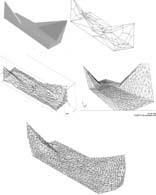 Mesh refinement schemes for topology and form. 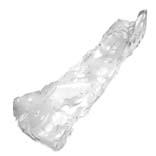 Laser cut model of expandable porous fabric membrane for envelope. |
|||
 Diagram of rigid and tensile truss. |
 Finite element analysis of normalized orthogonal grid. One of the interrelated features of the CFD and FEA studies is the discretization of a volume into a surface with internal geometry. The next set of experiments looked at using lightweight structural grids in a number of combinations including topological continuities between primary and secondary structures, membrification density, and member sectional geometry. |
 FEA analysis of structural mesh showing deflections. |
||
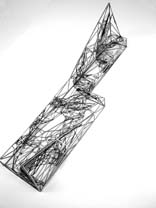 Laser cut model of topological primary and secondary structural systems. 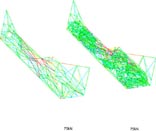 Topological secondary structural system, FEA analysis. |
 Structural mesh studies going from orthogonal grid (above right) to triangular to lightweight and finally (below right) combination of tensile and rigid frame members. Advanced engineering has recently embarked on a number of interesting experiments using biomimicry (Soft Kill Option) that go back to earlier experiments in the last century (Frei Otto's study of radiolaria) but which are driven purely by computational research. For the designer this poses problems because the mathematical and the computational means are often beyond the technical abilities of architecture. At the same time software developers are making it possible to perform engineering analyses within the design process. These are far from comprehensive "push this button and get a result" systems, which is important since the designer is forced to invent a problem. |
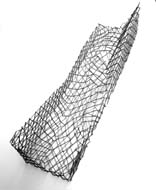 Structural mesh study. 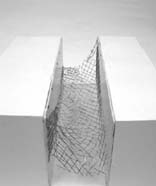 Structural mesh study. |
||
 Topological combined primary and secondary structural system, FEA analysis. The use of CFD is of course not limited to simply the analysis of certain architectural performance -e.g., ventilation, heating, and cooling- it also has a generative aspect. This is not unlike Gaudi's use of funicular chains to map the geometry of vaulting in his projects. In this case the same computational features are developed around liquids with very high surface tension and the use of CFD to generate complex porous meshes that have some degree of structural definition embedded within them. The experiment thus lies somewhere between Gaudi's funicular chains and Otto's experiment with soap film, surface tension, and minimal surfaces. This pressure on geometry has of course had certain historical shifts, but in one form or another, each has to confront the Vitruvian tradition and the ideality of geometry. The greatest problem with morphogenetic research is that it has sought this confrontation on the level of form, as though that were the essential place of categorical investigation. |
||||
 Rendering, East, street level. The primary analysis of the project involved comparing orthogonal, diagonal, and gradient grids for structural optimization. The key was to consider a number of recent developments in engineering referred to as SKO, or soft kill option. This is an FEA genetic code that optimizes structural performance by weeding out weak members and thickening remaining members. In the case of our research, the notion was to preserve and transform the geometry by applying a gradient function to the mesh. The tectonic investigations are a preliminary study for the development of lightweight structural systems that can be manufactured off site and installed easily on site. Sustainability and urban ecology are often identified as observable "green" design. The impetus for the further development of this research however is not to follow examples that have already been established, but rather promote new ones that unfold design methodologies that are specific to architectural production and insight, which is never linear and is certainly dirty. Peter Macapia pjm20@columbia.edu (1. to be continued) |
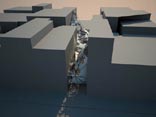 Rendering, West. |
|||
| Peter Macapia is the principal and director of the Design Office for Research and Architecture (DORA) in New York City. He received his Ph.D. from Columbia University in 2003 and has published on his own work as well as problems of ontology, matter, and geometry in architecture. The office is primarily concerned with design and engineering in relation to the geometry of material organization and develops projects and research through investigations of mathematics, material analysis, and computational techniques from fluid dynamics to finite element analysis. Peter is currently an Adjunct Associate Professor of Architecture in the Graduate School of Architecture, Planning and Preservation at Columbia University as well as at Pratt institute, where he is the director of Graduate Thesis in the Graduate School of Architecture. | ||||
| > DORA (DESIGN OFFICE FOR RESEARCH AND ARCHITECTURE) | ||||
| Per
qualsiasi comunicazione laboratorio
|